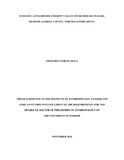| dc.description.abstract | Although scholars have advocated for a multi-disciplinary approach to the study of human and animal health, available evidence suggests that such studies are still limited. This thesis attempts to bridge this gap by focusing on the anthropology of Rift Valley Fever. It explores the interactions of ecology, livelihoods and Rift Valley Fever in Ijara division, North Eastern Kenya. Specifically, the thesis examines the adaptive strategies of pastoralist system as a livelihood practice and their influence on Rift Valley Fever occurrence as well as the socio-cultural, economic and political drivers of vulnerability to Rift Valley Fever. The indigenous knowledge base pertaining to Rift Valley Fever and its implications on public health delivery approaches was also assessed.
The study was guided by the Eco-health Model by MacElroy and Townsend (2004) as its theoretical framework. A descriptive and cross-sectional study design involving quantitative and qualitative methods of data collection was adopted. Data was collected from 204 survey respondents, 15 key informants, 48 focused group participants (4 FGDs of 12 participants each) and 5 case narratives. A combination of quantitative and qualitative techniques was applied in data analysis.
The findings suggest a close interaction of ecology, livelihood and Rift Valley Fever in different but connected ways. The periodic and unusual heavy rains in Ijara find a flat topography, fragile alluvial soil and poor vegetation cover that are unable to hold the water. This situation results in massive floods and large swarms of aedes mosquitoes which hatch in the flooded basins, dambos and water pans thereby causing imbalance in the ecosystem. The aedes mosquitoes which are the for Rift Valley Fever Virus then infect both humans and livestock with RVF virus through bites resulting in an epidemic of the zoonotic disease. The transmission and spread in livestock and human population is accelerated by entry risk pathways such as consumption of raw blood and milk that constitute the daily livelihood practices of the pastoralists. The socio-cultural and economic drivers of vulnerability to RVF were found to include animal ritual sacrifices, animal sleeping arrangements, gender roles and lack of institutional capacity to timely respond to RVF outbreaks. Finally, the study shows that the pastoralists are adept at recognizing the risk factors and risk pathways associated with RVF. Findings suggest that while people possess immense knowledge on Rift Valley Fever, this awareness has not been translated into behavior change transformation such as the adoption of safer health practices during outbreaks. This is partly due to the deep-seated socio-cultural practices and lack of compensation during bans on animal slaughter and animal trade during Rift Valley Fever outbreak.
It is concluded that there is a close interaction of ecology, livelihood and Rift Valley Fever in the study area. The interaction and mutual influence of abiotic, biotic and socio-cultural environments as explained in the eco-health model and supported by cultural ecology was apparent. Since pastoralism remains the most viable livelihood activity in the dry land ecosystem, intervention programmes will need to understand the socio-cultural practices which are intertwined with livelihood activities. Public health advocacy therefore remains critical to enable the pastoralists shake off the deep-seated but unsafe socio-cultural practices that act as drivers of Rift Valley Fever disease. | en_US |



